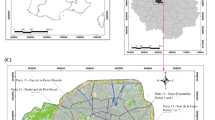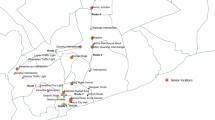Abstract
The objective of this work is to study the immediate transport flows of PM2.5 diesel exhaust emissions on a city sidewalk. Under calm conditions largest direct exhaust PM2.5 diesel concentrations tend to accumulate at two preferred heights: higher ones at 200–225 cm due to truck and buses aerodynamics, and lower ones at 130–160 cm due to light vehicles. Obtained flows indicate that exhaust emissions are transported to these heights via vortices generated by vehicular traffic. The lower height vortices transporting PM2.5 direct diesel emissions place children aged between 7 and 15 at a higher acute exposure risk due to their stature. Also, the hourly averaged PM2.5 concentrations tend to accumulate nearer to the roadside. This information was obtained using a specially designed electromechanical near-surface atmospheric profiler equipped with a PM2.5 measurement instrument, a thermistor and a sonic anemometer installed on a sidewalk. Using signal analysis techniques, coherent flows of direct PM2.5 emissions and thermal information were obtained. The proposed methodology can be used to evaluate before and after urban interventions, obtain full-scale sidewalk data for exposure studies and provides criteria on where to place sidewalk measurement instruments.
This is a preview of subscription content, access via your institution
Access options
Subscribe to this journal
Receive 6 print issues and online access
$259.00 per year
only $43.17 per issue
Buy this article
- Purchase on Springer Link
- Instant access to full article PDF
Prices may be subject to local taxes which are calculated during checkout








Similar content being viewed by others
References
Perez L, Lurmann F, Wilson J, Pastor M, Brandt SJ, Kunzli N, et al. Near-roadway pollution and childhood asthma: implications for developing “win-win” compact urban development and clean vehicle strategies. Environ Health Perspect. 2012;120:1619–26.
Kim JJ, Smorodinsky S, Lipsett M, Singer BC, Hodgson AT, Ostro B. Traffic-related air pollution near busy roads: the East Bay Children’s Respiratory Health Study. Am J Respir Crit Care Med. 2004;170:520–6.
Chen H, Kwong JC, Copes R, Tu K, Villeneuve PJ, van Donkelaar A, et al. Living near major roads and the incidence of dementia, Parkinson’s disease, and multiple sclerosis: a population-based cohort study. Lancet. 2017;389:718–26.
Cacciottolo M, Wang X, Driscoll I, Woodward N, Saffari A, Reyes J, et al. Particulate air pollutants, APOE alleles and their contributions to cognitive impairment in older women and to amyloidogenesis in experimental models. Transl Psychiatry. 2017;7:e1022.
E Heck, Julia & Wu, Jun & Lombardi, Christina & Qiu, Jiaheng & J Meyers, Travis & Wilhelm, Michelle & Cockburn, Myles & Ritz, Beate. (2013). Childhood Cancer and Traffic-Related Air Pollution Exposure in Pregnancy and Early Life. Environmental health perspectives. 121. 10.1289/ehp.1306761. 5.121(11–12) · September 2013.
Watson AY, Bates RR, Kennedy D. Health Effects Institute. Air pollution, the automobile, and public health. viii. Washington, D.C: National Academy Press; 1988. p. 692.
Holguin F, Flores S, Ross Z, Cortez M, Molina M, Molina L, et al. Traffic-related exposures, airway function, inflammation, and respiratory symptoms in children. Am J Respir Crit Care Med. 2007;176:1236–42.
McMeeking GR, Bart M, Chazette P, Haywood JM, Hopkins JR, McQuaid JB, et al. Airborne measurements of trace gases and aerosols over the London metropolitan region. Atmos Chem Phys. 2012;12:5163–87.
Takahashi K, Minoura H, Sakamoto K. Chemical composition of atmospheric aerosols in the general environment and around a trunk road in the Tokyo metropolitan area. Atmos Environ. 2008;42:113–25.
Jazcilevich A, Wellens A, Siebe C, Rosas I, Bornstein RD, Riojas-Rodríguez H. Application of a stochastic vehicular wake erosion model to determine PM 2.5 exposure. Aeolian. Research. 2012;4:31–7.
Kanda I, Uehara K, Yamao Y, Yoshikawa Y, Morikawa T. A wind-tunnel study on exhaust gas dispersion from road vehicles—Part I: Velocity and concentration fields behind single vehicles. J Wind Eng Ind Aerodyn. 2006a;94:639–58.
Kanda I, Uehara K, Yamao Y, Yoshikawa Y, Morikawa T. A wind-tunnel study on exhaust-gas dispersion from road vehicles—Part II: Effect of vehicle queues. J Wind Eng Ind Aerodyn. 2006b;94:659–73.
Bhautmage U, Gokhale S. Effects of moving-vehicle wakes on pollutant dispersion inside a highway road tunnel. Environ Pollut. 2016;218:783–93.
Sudin MN, Abdullah MA, Ramli FR, Musthafah MT, Shamsudin SA. Review of research on vehicles aerodynamic drag reduction methods. Int J Mech Mechatron Eng. 2014;14:35–47.
Wallace LA, Wheeler AJ, Kearney J, Van Ryswyk K, You H, Kulka RH, et al. Validation of continuous particle monitors for personal, indoor, and outdoor exposures. J Expo Sci Environ Epidemiol. 2011;21:49–64.
Oppenheim AV, Schafer RW. Discrete-time signal processing. Englewood Cliffs, N J: Prentice Hall. 1989;xv:879.
Mallett JD, Brennan LE. Cumulative probability of detection for targets approaching a uniformly scanning search radar. Proc Ieee. 1963;51:596–601.
Papoulis A, Pillai SU. Probability, random variables, and stochastic processes. Tata McGraw-Hill Education: 2002. ISBN 10: 0071199810.
Holmén V. Methods for vortex identification. PhD Thesis, Lund University, Sweden, 2012. ISSN 1404–6342.
Secretaría de Salud, Materno Infantil. Vigilancia Nutricional, Apéndice B Gráfica Peso Talla edad 6-18 años. Consulted, December 2018 at http://www.salud.gob.mx/unidades/edi/nom/Image29.gif.
Acknowledgements
To project CDMX CM-SECITI/063/2018. We acknowledge the technical help of José Manuel Hernández, Gema Luz Andraca, Oscar Augusto Peralta, Ruben Pavia Hernández, Brenda Liz Valle Hernández, Rafael Nery Liñan Abanto, Manuel García Espinosa, Wilfrido Gutiérrez López and Miguel Angel Robles.
Author information
Authors and Affiliations
Corresponding author
Ethics declarations
Conflict of interest
The authors declare that they have no conflict of interest
Electronic supplementary material
Rights and permissions
About this article
Cite this article
Jazcilevich, A., de la Cruz Zavala, J., Erazo Arcos, A.M. et al. Sidewalk pollution flows caused by vehicular traffic place children at a higher acute exposure risk. J Expo Sci Environ Epidemiol 29, 491–499 (2019). https://doi.org/10.1038/s41370-018-0083-4
Received:
Revised:
Accepted:
Published:
Issue Date:
DOI: https://doi.org/10.1038/s41370-018-0083-4
Keywords
This article is cited by
-
Analysing and predicting the fine-scale distribution of traffic particulate matter in urban nonmotorized lanes by using wavelet transform and random forest methods
Stochastic Environmental Research and Risk Assessment (2023)



